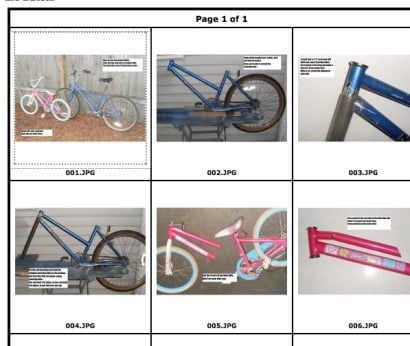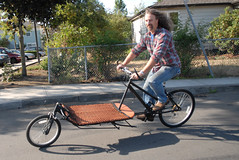Remember Tom LaBonty? He’s the Lents Neighborhood resident who builds home-made, “hillbilly-type” cargo bikes in his backyard. Since we profiled Tom back in August he’s picked up a few customers, launched TomsCargoBikes.com, and now he wants to share his methods with the world.
Tom has launched a do-it-yourself cargo bike building guide. The guide features a slideshow with instructions on how to take two used bikes and convert them into a front-loading, bakfiets-style cargo bike.

From his website:
“The following pictures show the steps to making one of my “hillbilly” type cargo bikes. I have provided these photos for those who might want the satisfaction of building and riding their own rattletrap. I didn’t include every step (just the one’s I think are important) you’re going to have to use some imagination. Also, you’ll notice very few measurements, just estimates,it’s all part of your adventure. I’m from the “measure once, cut twice” school of design. Go ahead and use some of my ideas or just straight up copy it….”
If all you want for Christmas is a cargo bike, but you don’t have the funds to make it happen (and you’re not afraid of a little backyard bike tinkering), this might be just what you need. Check out TomsCargoBikes.com to get started.







Thanks for reading.
BikePortland has served this community with independent community journalism since 2005. We rely on subscriptions from readers like you to survive. Your financial support is vital in keeping this valuable resource alive and well.
Please subscribe today to strengthen and expand our work.
i love it!
That is what is called hillbilly deelux, much like three mobile homes connected together to form a horseshoe shape with a kiddy pool sitting next to a car on blocks in the “courtyard.”
I would love to see some follow up reporting on how many “do it yourself” cargo experiments result in personal injury due to frame failure.
Awesome! Thanks for sharing, Tom.
I got a good laugh out of reading the captions of the slideshow.
James–probably not many.
sharing your ideas with the world doesn’t sound like the best way to build a new business…i mean, if anyone can do it, why would they need Tom?
i wish him luck though..its a tough market to get into.
Justa-not many, but some?
It made me cry to see the little pink bike’s tubes cut and broken. ;-(
I built one and it has held up for a year now with no additional work needed. I am in the process of building version 2.0 (based on what I’ve learned) and although it is quite different from Tom’s his are very nice and sturdy.
I have ridden a few of Tom’s and we have swapped tips on design. I really like the simplicity of this build.
Thanks for sharing Tom!
Toms Website is down. Any chance you can send me some pics and or measurements of your builds? What angles were important in that picture I can’t read it. Any help would be great.
I don’t know him but now I love him.
Tom, that’s the best use of scrap metal I’ve seen in a long time! Thanks for sharing.
James @ 2:
I think a lot of that would depend on the skill of the person doing the welding. Obviously, unless one had experience and access to heliarc welding, the only parts you could use would be from steel frame/fork, and even then I’d avoid real thin steel tubing; it’s harder to get the welds right.
The other potential problem with welds is that many of the dept. store bikes (that look like the little pink one in the pics) come with horrible welds right from the factory. The biggest CPSC recall & fine in bicycling history, $1.4 mil. was against Dynacraft a few yrs. ago, mostly for faulty welds at the fork crown pitching kids over the handlebars into a faceplant. If you pick up a bike that might be from that large nation in the western Pacific (not Tiawan), look at the decals down near the bottom of the seat tube to identify the manufacturer. If you see “Dynacraft”, I recommend you set the bike back down & look for something else. Many of these bikes were sold through a dept. store named “W…” & made to their specs.
Where to get frames/forks: Police auction sales, laying abandoned by the roadside or thrown in the trash or CCC. CCC, 1700 Alberta, gets hundreds of suitable bikes donated to them. Many are not worth repairing & can’t be sold, so they strip them for usable parts & toss the frames/forks/handlebars, etc. in their giant scrap metal bin. I bet that for $5-10 they would let you go through their “teardown” pile & pick out what bikes you need. Better yet, go down there to their volunteer teardown group on Sunday about 10AM, spend a couple hours doing community service work – they supply tools – & you could probably pick out what scrap frames/forks, etc you need for free. Call CCC first to make sure it’s OK with them – ask for James, their recycling coordinator.
Carrying cargo is serious business. The forces involved are high. Perhaps not when all is going well but when mistakes are made, potholes are hit, etc. Force potential rises with velocity. While I appreciate the DIY initiative of many PDX citizens, do respect the risks involved in such an endeavor.
Tom’s creativity deserves praise, I’ve been watching his website for a while now and I think he has lots of potential. I’d like to find a place where builders could meet and work together on projects without having to spend $100’s of dollars every month on membership fee’s
I wish I had voted for Tom in lieu of Barrack. He is change we can believe in.
james; when i lived in minneapolis tall bikes were all the rage. i can’t stand them generally. if all the brain dead punks in the west bank can make tall bikes, and they didn’t fail catastrophically, then someone with any skill with a torch can make a cargo bike that should work just fine.
also, given that there are these instructions tom is putting out, i’d think that that’s a huge help. the crusty kids, to the best of my knowledge, were all just winging it.
Yes, I do want a cargo bike.
In the great tradition of do-it-yourself magazines, Tom LaBonty’s nice pics make a project like this look so easy at first glance. If they don’t already know, anyone deciding to try building this bike using the approach he did is going to learn a bunch, especially if they follow through and complete it.
Think of all the skills involved: measuring, cutting, welding, ability to evaluate materials capability and suitable application to the service it will have to provide. Also, the ability to visualize design options and devise solutions to problems. Some people have a knack for doing this kind of thing. The motorhome bike guy, Brian Campbell seems like another one that can.
Structurally, the job LaBonty did on this bike looks pretty good. His welds look pretty good and strong. A lot of people don’t care if welds are sanded and smoothed all purty like a high end hand made racing bike, just as long as they work.
Doubts about the bike’s structural integrity can easily be laid to rest with a little field testing. Put one of the fancy Dutch bikes up against it. The results hould be interesting.
todd, i’m with you man…. perhaps we should consider starting the “pink bike preservation society”?
a tip to all the hipsters out there~pink is the new black…
James — concerns taken, but once upon a time, Popular Mechanics (remember that magazine?) published all sorts of DIY projects for everything from windmills to pedal-cars, and none of their articles was ever preceded by ten pages of disclaimers. It was ASSUMED that anyone trying out a design in PM was responsible for whatever happened. Period.
We live in a litigious atmosphere that has killed off a lot of natural curiosity, innovation and personal responsibility for one’s own inventiveness, and I think that’s a shame.
Tom LaBonty is offering us a chance to be responsible for our own mobility in a refreshing and novel way. And it’s keeping cast-off bikes out of the landfill. Where’s the downside? I don’t see it.
Way to go Tom!
@bahueh…”sharing your ideas with the world doesn’t sound like the best way to build a new business…i mean, if anyone can do it, why would they need Tom?
i wish him luck though..its a tough market to get into.”
There are several good examples of “open source” efforts that have have added tremendous value to the user community and have provided nice returns for the founders. Just a few:
* Linux operating system
* Wikipedia
* Firefox browser
Tom has mentioned that not all the details have been provided and others have pointed out that not everyone can weld. This leaves Tom and others free to sell hardware kits, accessories, workshops, services, etc. And don’t forget donations to the founder!
Open source can be a good way to get an idea to market and can lead to rapid adoption and innovation through the participating community. It appears that Tom knows exactly what he’s doing here.
Hats off to you Tom and best of success!
Mnay thanks to Tom for encouraging the open-source development of cargo bikes- this is absolutely awesome. It makes me sad to admit that my MIG welder has sat in a corner unused for many months – this is just the inspiration I need!
As for James and his concern – this DIY endeavor is just like any other project. It is only as safe as the skills and judgement of the fabricator. Manufactured products that fail are dangerous because the consumer has no knowledge of how it was built or what potential weaknesses might be, and has the “expectation” of safety. But the nice thing is that if you built it, you can evaluate it, break it and you can fix it. And like any vehicle, you should check out all safety systems before throwing those bags of cement in the cargo area. So lighten up…everything will be fine. BTW, this is coming from someone who had an aluminum BMX frame break in two unexpectedly.
“While I appreciate the DIY initiative of many PDX citizens, do respect the risks involved in such an endeavor.”
If you are verse on your mtn. biking history, it was all about DIY in the early days and they were bombing down mtns it!
Hillbilly? How about Portland ingenuity that isn’t all about outrageously overpriced bike products for a change?
Finally, some REAL pdx bike innovation. Way to go!
…I like it a lot…
I’m going to start building one today!!I’ll report back with my progress.
Cheers for the inspiration.
Boo to all the poopy pants haters out there. You(haters)have no imagination. Step outside the box or cubicle once and a while.
More people should be making there own stuff, ameriKa would be a lot mo betta if people used there brains more often….
James #’s 3&7..
In my experience not any more than on factory built bikes, and also from my experience structural failure was not as much of an issue as 5 poor drivers and one tree branch that fell on me.
Also-
I love the step by step guide and am surprised he’s not selling it.
I hate to point this out but it looks like Tom just got two of his cargo bikes stolen on Dec. 30th – see:
http://bikeportland.org/2010/01/01/aqua-tomscargobikescom-cargo-bike/
http://bikeportland.org/2010/01/01/black-tomscargobikescom-cargo-bike/
The bikes are VERY unique though – if we get the word out it wouldn’t be that hard to identify them out in the wild.
-bhance